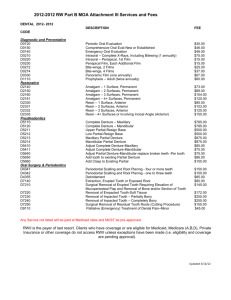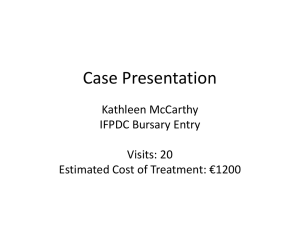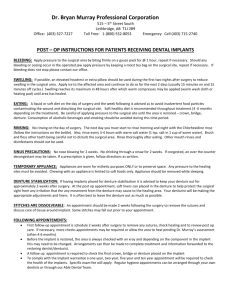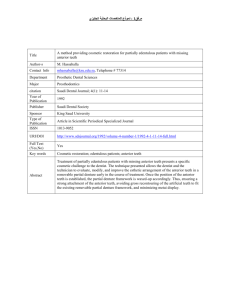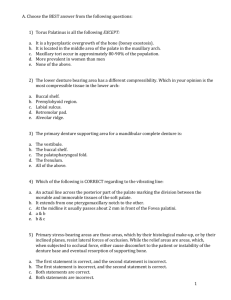Hand Out - Punjabi Dental Society
advertisement
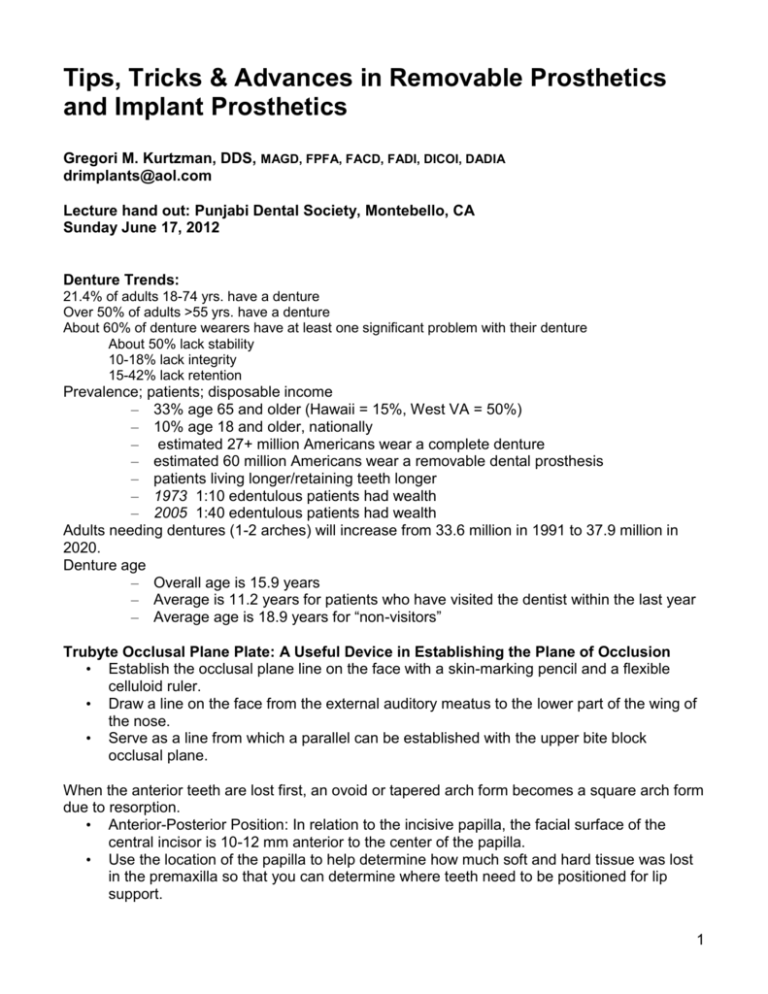
Tips, Tricks & Advances in Removable Prosthetics and Implant Prosthetics Gregori M. Kurtzman, DDS, MAGD, FPFA, FACD, FADI, DICOI, DADIA drimplants@aol.com Lecture hand out: Punjabi Dental Society, Montebello, CA Sunday June 17, 2012 Denture Trends: 21.4% of adults 18-74 yrs. have a denture Over 50% of adults >55 yrs. have a denture About 60% of denture wearers have at least one significant problem with their denture About 50% lack stability 10-18% lack integrity 15-42% lack retention Prevalence; patients; disposable income – 33% age 65 and older (Hawaii = 15%, West VA = 50%) – 10% age 18 and older, nationally – estimated 27+ million Americans wear a complete denture – estimated 60 million Americans wear a removable dental prosthesis – patients living longer/retaining teeth longer – 1973 1:10 edentulous patients had wealth – 2005 1:40 edentulous patients had wealth Adults needing dentures (1-2 arches) will increase from 33.6 million in 1991 to 37.9 million in 2020. Denture age – Overall age is 15.9 years – Average is 11.2 years for patients who have visited the dentist within the last year – Average age is 18.9 years for “non-visitors” Trubyte Occlusal Plane Plate: A Useful Device in Establishing the Plane of Occlusion • Establish the occlusal plane line on the face with a skin-marking pencil and a flexible celluloid ruler. • Draw a line on the face from the external auditory meatus to the lower part of the wing of the nose. • Serve as a line from which a parallel can be established with the upper bite block occlusal plane. When the anterior teeth are lost first, an ovoid or tapered arch form becomes a square arch form due to resorption. • Anterior-Posterior Position: In relation to the incisive papilla, the facial surface of the central incisor is 10-12 mm anterior to the center of the papilla. • Use the location of the papilla to help determine how much soft and hard tissue was lost in the premaxilla so that you can determine where teeth need to be positioned for lip support. 1 Papilla sits entirely lingual to the facial of the ridge = little tissue lost and minimal or no lip support needs to be added, treatment with fixed prosthetics on implants may be done, use of a flange on a denture in this area can create “puffiness” to lips Papilla sites at the crest of the ridge = slight to moderate tissue lost and some lip support may be needed which can be accomplished with fixed prosthetics on implants, a denture or overdenture Papilla sits facial to the crest = moderately severe tissue loss, fair amount of lip support will be needed and a fixed option on implants may not be possible, overdenture on implants or standard denture should be considered. Discuss with the patient lip position and tooth display at the beginning. Show them their smile, lip position and any asymmetry. Telling them before is a reason. Afterwards is viewed as an excuse. Information to communicate to lab on the wax rim: Lip line: Should indicate both the at rest position and smile position as this guides the lab as to how much tooth display and how much gingival display when smiling. Midline: Does facial midline match the dental midline? Patients will identify errors in facial midline much more readily then dental midline. Posterior teeth available based on Cuspal inclination: • Anatomical: Euroline™ 400, 330, 300 P-T • Semi-Anatomical: 220 (BioStabil), 200, Functional, Anatoline • Non-Anatomical: (Flat Plane) Monoline, Rational, 00 Avoid 0 degree or non anatomical as they are more difficult for patients to chew foods. Lingualized occlusion: • Maxillary lingual cusp/Mandibular fossa • Balanced or nonbalanced set-up possible • Virtually any tooth design can be incorporated into a lingualized scheme when using a high cusp/low cusp • Can use in Class I, II, or III and cross-bite • Benefits include: Cusp form and esthetics more natural Good food penetration Bilateral balance is possible Vertical forces centralized Easily adjusted in the mouth Stress distribution may be improved What to check as wax try-in: Midline Harmony Relation of Anterior Teeth to the Lips (smile line) Prominence of Canines Anterio-posterior Position of Anterior Teeth (lip support) Occlusal Plane Overall Aesthetic and Phonetic Factors Vertical Dimension Centric/Occlusal Relation Overall Patient Acceptance 2 Key to a quality good fitting denture is starting with a great impression. We need to capture all anatomical landmarks including: Entire vestibule Posterior palatal vibrating line (maxillary) Retromolar pad (mandibular) Retention of denture teeth: Can be improved by placing diatorics for the resin to lock into. Especially true with the higher end denture teeth as these do not chemically bond well to the denture base. Creating a circumferential collar around the denture tooth locks it in better. Creating divergent cuts on the ridge side of the denture tooth locks it better. Diatorics most critical on maxillary anterior teeth as often there is minimal resin on the lingual to hold them in and pop out occurs. Tray-Bite: prefabricated wax rim and thermoplastic moldable tray. Available in 3 sizes per arch. Eliminates need for 2 appointments to secure impressions and records, can be done in 1 appointment. Bite records: never send wax bites as they are unstable expecially in hot weather and can distort. Most labs hand articulate when a wax bite is in the lab box. Use rigid PVS bites and cut index into the wax rim so should the bite come off the rim there is no guess work as to how it articulates back to the rims. Triad 2000 unit: Cures Triad gel, Triad Transheet, VLC temp C&B materials. Interra unit: Cures Triad gel, Triad Transheet, VLC temp C&B materials, Eclipse baseplates, Radica temp C&B material, iNterra occlusal guards, Eclipse occlusal guards, Cristobal. (do not cure Eclipse setup and contour resins) Eclipse unit: Cures all VLC materials including Eclipse setup and contour resins. Eclipse Dentures: Benefits of Eclipse resin denture base vs traditional denture bases (Lucitone 199) Conventional acrylics shrink 7% Eclipse 3% (more stable better fitting denture bases) Eclipse is Monomer free, conventional acrylics contain monomer (potential allergic reactions) The Eclipse base plate becomes part of the final denture so retention and stability are observed early in the process. With conventional acrylics retention is always hopeful after processing. Eclipse is light curable so can be processed in 1 hour. Conventional acrylics need to be packed and flasked requiring 6-8 hours to process. What’s needed: Chairside only: Eclipse baseplate with teeth in setup resin: Electric spatula to move teeth if needed or a hot water bath Eclipse baseplate with teeth set in wax: No special items required Baseplates only: Interra or Eclipse VLC unit needed (can not be cured with a Triad 2000 unit or hand held light) 3 Conditioning oven (suggested) Eclipse dentures: Eclipse Conditioning oven and VLC unit needed (can not be cured with a Triad 2000 unit, hand held light or iNterra unit) Flexible partial dentures: Injectable nylon (ie Flexite, Valplast etc) undergo creep of the clasp and rests over time creating a looser fit that can not readily be corrected. Teeth held by mechanical retention and when tooth pop out occurs difficult to reinsert the tooth. Can not be relined or have teeth added. Acetyl (ie Thermoflex) material in clasps and rests does not undergo creep so fit remains stable over time. Frame or clasps can be embedded in Eclipse or conventional acrylics so teeth can be better retained, replaced more readily when a tooth pops off or a tooth needs to be added. Can be relined chairside or at lab using conventional materials. Clasps can be used with conventional metal frames. Implant over-dentures: Over-denture: uses free-standing implants with individual attachments. Bar Over-denture: connects the implants with a bar that has attachments on the bar. Rational for free-standing vs bar over-dentures: if there is sufficient ridge to resist lateral displacement and the patients only complaint is lift off during function then free-standing will work well. If there is lateral displacement then a bar is needed to prevent lateral loading of the implants and displacement of the denture during function. Number of attachments per arch needed: 3-4 attachments are all that is needed whether using free-standing or a bar approach. The determination of whether 3 or 4 are needed depends on the patients arch size and spread of the attachments. Exceed 4 attachments, may make it difficult for patient removal of the prosthesis. Use of an Eclipse baseplate allows the attachments to be incorporated into the base plate providing a stable base to capture records and this is then incorporated into the final prosthesis. A baseplate is made with cutouts over each attachment. The baseplate in inserted over the portion of the attachment that will be incorporated into the denture and is luted to the Eclipse baseplate with a light curable resin such as Triad gel. The baseplate can already have the wax-rim present with no wax over the area where the attachments are being picked up. Following luting of the attachments to the baseplate the records can be taken and sent to the lab. The lab will then set the teeth on the same baseplate and try in is easier and the denture is stable to check the occlusion. Denture duplication: Assists with: Emergency rapid denture Surgical stent based on the wax setup or already fabricated denture CT stent fabrication Fabrication of custom trays using the patient’s old dentures for new dentures What’s needed: Lang denture duplicator, alginate, acrylic resin When using clear acrylic immersion of the duplicator filled with clear resin into a pot of hot water provides a crystal clear stent. Allowing to cure at room temp provides a cloudy stent. 4 Implant prosthetics: Fixed and Bar Over-dentures The edentulous arch falls into three basic forms; ovoid - most common square - more common in implant patients due to labial bone loss, especially in the maxilla ………….when the incisors are lost before the canines tapered - often found in skeletal class II patients When the anterior teeth are lost first, an ovoid or tapered arch form becomes a square arch form due to resorption. In relation to the incisive papilla, the facial surface of the central incisor is 10-12 mm anterior to the center of the papilla. After lose of the teeth the ridge resorbs. When restoring, soft tissue may need to be replaced as well as the missing teeth. Discuss with the patient lip position and tooth display at the beginning. Show them their smile, lip position and any asymmetry. Telling them before is a reason. Afterwards is an excuse! A - P Spread: The distance between a line drawn through the most anterior implant and a line drawn through the most posterior implants. This is used to determine how far the prosthesis can be cantilevered distal to the most posterior implants. The rule of thumb is: A prosthesis can be cantilevered 1.5 timesthe A-P spread…….. But this is dependant on the density of the bone and the number of implants placed. And should not exceed 13mm in the mandible and 11mm in the maxilla. Implant supported: the implants upon occlusion are loaded by occlusal forces. Single crowns, fixed bridges, bar-overdentures Implant retained: upon occlusion the tissue is loaded and minimal load is placed on the implants. Upon removal of the prosthesis load (tensile) is placed on the implants. Free standing (stud) and bar-overdentures Soft tissue master model is critical to fit of the prosthesis. Verification stent needs to be made to transfer accurate positioning of the implants positioning and timing to the lab. Make the stent using open tray impression heads intraorally then pickup in open tray impression. This cuts out a patient visit verses taking impression and having the lab send verification stent for try-in. 5 Verification stent can be made with one of the following: Floss and Triad gel (light cure) TranSheet resin (light cure) GC Pattern resin (self cure) Verification stent should be cured in segments to minimize any polymerization shrinkage. Polymerization shrinkage is related to volume of the material being cured. The greater the volume the greater total shrinkage. Open tray heads are more accurate then closed tray with less potential accuracy issues. Use open tray when possible. Reserve closed tray for: restricted vertical cases in posterior, single units. Cast vs Cad/Cam; All cast structures have micro bubbles in them creating potential weak areas and have more fit issues due to contraction and expansion of the materials and process employed to construct them. Cad/Cam are stronger as they are milled from solid block of metal so no porosity present. Master model is scanned so that the milled prosthesis fits the model and has eliminated contraction and expansion issues of the materials. Always radiographically verify: Impression heads before making verification stent or taking impression Fit of the verification stent if made separately Fit of the frame at try in Compartis ISUS: Cad/Cam for hybrid and bar over-dentures What needs to be sent to the lab: Wax-setup of the prosthesis desired Accurate soft tissue model The lab sends the above to Compartis to have a scan made of the soft tissue model and also the wax try-in. A virtual frame is designed and returned to the lab. Using special software the lab and DDS can check the design and make any corrections needed. Upon approval the frame is milled and returned to the lab. Materials available: Chrome cobalt: Can be used for bar over-dentures and for hybrid frames (if porcelain is to be fused to the metal does not have the masking issues associated with titanium) Titanium: bar over-dentures, hybrid when denture teeth will be applied or overlay with a light curable resin. Prosthesis is screw retained, not offered as a cementable option. Cementable vs screw retained: Fewer components needed when screw retained as prosthesis can be done to implant level. Fewer parts equals fewer long term issues. When using cementable prosthetics, separate abutments needed. Also one has to deal with potential cement left in the gingival sulcus. 6 Easier to get passive fit with screw retained then cemented. Preplanning eliminates issues with screw access position. Improving communication with the lab with removable prosthetics: Including the patient in the process of selecting the denture tooth shade and shape helps eliminate dissatisfaction at treatment completion. TrueRx allows the patient to see what the different shades and tooth shapes look like in a simulated picture of themselves. This can be printed and sent home with the patient or transmitted to the lab to give the lab a better idea of what they are working with. Process can be done by the auxillary and patient with final discussion with the dentist. TrueRx software helps select the tooth shade, anterior and posterior mold and provides an emailable or printable lab prescription giving more detailed instructions to the lab on what is desired and what teeth to use. Misc. Items mentioned: Eclipse (denture resin) Available from Dentsply Prosthetics Thermoflex (acetyl material for denture clasps and partial denture frames) Available from Dentsply Prosthetics Locator Attachment Available from Zest Anchors or dental implant companies www.zestanchors.com Guide Rite surgical sleeves (for implant surgical stents) Available from Deplaque http://www.deplaque.com/ShopOurProducts/tabid/78/c/professionalproducts/Default.aspx Zirconia cutting diamonds Available from Komet http://www.kometusa.com/fileadmin/user_upload/pdfs/Konnect/zr_diamonds_09_2011_net.pdf Titanium abutment modification carbides (APB Kit 4475) Available from Komet http://www.kometusa.com/ Cad/Cam milled hybrid and overdenture bars Available through your lab from Dentsply Compartis ISUS http://www.dentsply.com/en/solutions/us/prosthetics/ Triad Gel and TranSheet light curable resin 7 Available through your dental supplier from Dentsply http://www.dentsply.com Questions on dental cases: Feel free to email me on any dental case questions. It is helpful that when emailing on a case to provide digital radiographs, clinical pics and any other information that will help in discussing the case. Don’t have digital radiographs? Place a film radiograph on an illuminated view box and using a digital camera with no flash take a picture of the film. Feel free to email me at: drimplants@aol.com or find me on Facebook at http://www.facebook.com/ImplantCosmeticDentalCenter or check out our website at www.maryland-implants.com Smart phone? 8
